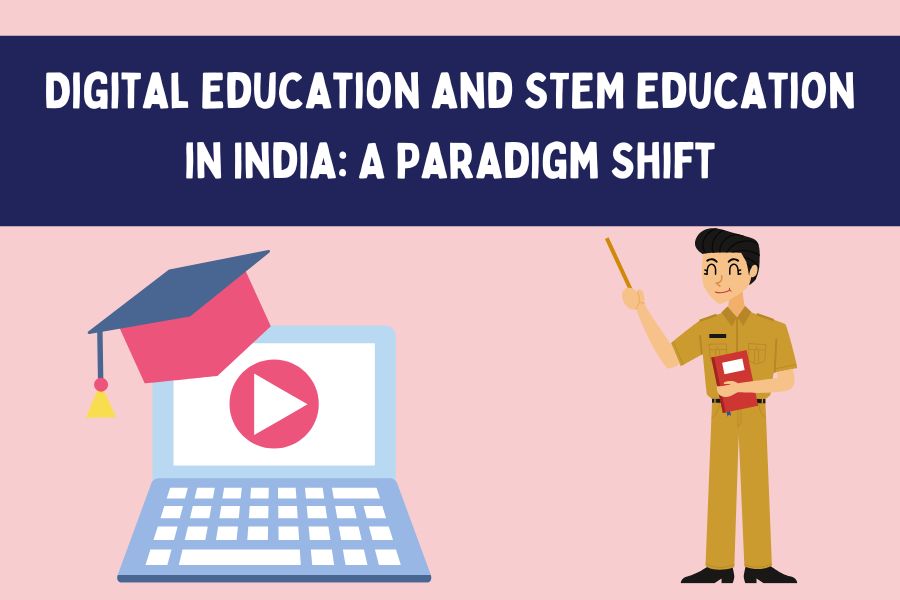India’s education system is undergoing a massive transformation, thanks to the integration of technology and a focused push towards STEM (Science, Technology, Engineering, and Mathematics) education. As the country embraces these advancements, digital education and STEM learning are emerging as the pillars of a modern, skill-driven society.
The Rise of Digital Education in India
What is Digital Education?
Digital education leverages technology to deliver learning experiences. It includes online classes, e-learning platforms, digital tools, and mobile apps designed to make education accessible, interactive, and engaging.
The Need for Digital Education
India’s vast geographical expanse and socio-economic diversity present significant challenges in ensuring equitable access to quality education. Digital education bridges this gap by enabling students from remote areas to access the same resources as those in urban centers. This shift became even more prominent during the COVID-19 pandemic when schools and colleges pivoted to online learning.
Advantages of Digital Education
- Accessibility: Students can learn from anywhere with an internet connection.
- Personalized Learning: Adaptive technologies provide tailored experiences to cater to individual learning speeds and styles.
- Cost-Effectiveness: Reduces costs associated with physical infrastructure and traditional learning materials.
- Interactive and Engaging Content: Multimedia tools like videos, simulations, and gamified learning enhance understanding and retention.
Challenges in Digital Education
Despite its benefits, digital education in India faces challenges such as:
- Limited internet penetration in rural areas.
- Lack of digital literacy among students and teachers.
- High costs of devices like smartphones and tablets.
Government Initiatives
The Indian government has introduced several programs to promote digital education:
- Diksha Platform: A comprehensive platform for teachers and students to access digital resources.
- E-Pathshala: Offers free e-books and learning materials across multiple languages.
- PM e-Vidya: A multi-mode access initiative launched during the pandemic to unify digital education efforts.
The Importance of STEM Education in India
What is STEM Education?
STEM education focuses on an interdisciplinary approach to learning where students apply science, technology, engineering, and mathematics to real-world problems.
Why STEM Matters
India’s growing prominence as a global technology hub underscores the importance of STEM education. By equipping students with problem-solving skills and critical thinking abilities, STEM lays the foundation for innovation and economic growth.
Current Scenario of STEM Education in India
While India produces a significant number of engineers and scientists annually, the quality of STEM education remains inconsistent. A lack of practical exposure and an overemphasis on rote learning often hinders students from developing essential skills.
Benefits of STEM Education
- Encourages Innovation: Promotes creativity and out-of-the-box thinking.
- Bridges the Skill Gap: Prepares students for emerging fields like artificial intelligence, robotics, and data science.
- Boosts Employment Opportunities: STEM graduates are highly sought after in technology-driven industries.
Challenges in STEM Education
- Resource Constraints: Many schools lack laboratories and modern equipment.
- Limited Teacher Training: Teachers often lack the requisite skills to effectively deliver STEM curricula.
- Gender Disparity: Girls are underrepresented in STEM fields due to societal biases and lack of encouragement.
Government Efforts to Strengthen STEM Education
- Atal Innovation Mission (AIM): Aims to foster innovation and entrepreneurship through initiatives like Atal Tinkering Labs.
- INSPIRE Program: Encourages young minds to pursue research careers in STEM fields.
- National Education Policy 2020: Emphasizes experiential learning, coding, and integration of STEM disciplines from an early age.
Bridging Digital Education and STEM Education
Digital tools play a crucial role in making STEM education more effective and accessible. Virtual labs, augmented reality, and coding platforms are enabling students to experiment and innovate in ways that were previously unimaginable.
Read Also>>> Effective Digital Marketing Strategies for Plumbers: A Path to Online Success
Examples of Integration
- E-Learning Platforms: Platforms like BYJU’S, Vedantu, and WhiteHat Jr. offer interactive STEM-based courses.
- Robotics Kits and Simulations: Tools like Arduino and Tinkercad allow students to build and test projects digitally.
- Coding for Kids: Initiatives like ‘Hour of Code’ introduce children to programming languages in a fun and engaging way.
The Road Ahead
To maximize the impact of digital and STEM education, India must:
- Improve Infrastructure: Invest in broadband connectivity and affordable devices for students in rural areas.
- Focus on Teacher Training: Equip educators with digital tools and STEM teaching methodologies.
- Promote Inclusivity: Encourage more girls to participate in STEM fields through scholarships and mentorship programs.
- Enhance Industry Collaboration: Partner with tech companies to provide hands-on training and internships.
Conclusion
Digital education and STEM education are not just educational reforms but transformative forces shaping India’s future. While digital education ensures inclusivity and accessibility, STEM education empowers students to innovate and excel in a technology-driven world. By addressing the existing challenges and fostering collaboration between stakeholders, India can unlock the true potential of its youth and secure its position as a global leader in education and technology.





